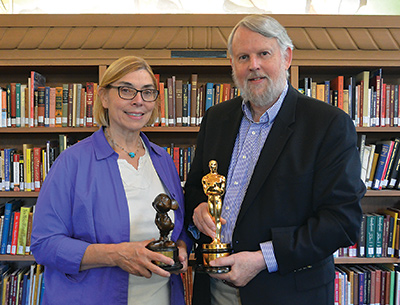Donor Story
AND THE OSCAR GOES TO…
Elmo Williams’ Estate Gift to UNM Libraries Reflects a Life in Film and Television
BY Hilary Mayall Jetty
Posted May 5, 2017
If Elmo Williams hadn’t been a courteous young man, he never would have met legendary film star Gary Cooper, and High Noon might have been a box office flop instead of an Academy Award-winning classic. And The University of New Mexico Libraries would have missed out on an important collection of film and television history.

Stacy Williams and Dean of The UNM College of University Libraries and Learning Sciences Richard Clement pose with the Oscar and “Mousecar” won by Stacy’s late father, Elmo Williams, whose estate gifted his collection of film and television memorabilia to UNM. Photo: Mario Lara
Elmo was 2 years old in 1915 when his family became homesteaders in Capulin, N.M. All his life he cherished growing up in that wild landscape in far northeastern New Mexico, where he watched their adobe home rise from the earth and played with his four siblings.
“Dad’s connection to land, particularly New Mexico, was intense,” said Stacy Williams, Elmo’s daughter. “His memories were wonderful—the farm, the daily routine. They’d go to the general store, where his dad was a great storyteller around the fireplace in winter. That sense of connection and community was profound.”
When Elmo’s mother decided to return with her children to her native Oklahoma, Elmo grieved, but she encouraged him to seek bigger dreams. In the bleak Great Depression years, Elmo graduated from high school, and then headed for the promise of work and higher education in Los Angeles.
Sealing a Destiny
Elmo became a carhop at a drive-in restaurant. No one there was eager to serve a patron named Merrill White. He was a regular, but demanding, so the youngest employee was given the task. Elmo’s pleasant demeanor won over the cantankerous customer, and one day White made a surprising offer. White, a film editor and screenwriter, was about to sail for London and his assistant couldn’t go. He asked the bright young man to accompany him.
Elmo’s leap of faith sealed his destiny. Starting as an errand runner, he quickly learned about filmmaking, and within three years he and White were partners. “He was trained to edit film and work with sound,” Stacy explained, “because in those days the film editor was also cutting sound effects, music, visual effects, and in some cases, the negatives.”
In 1952, Elmo won an Academy Award for editing High Noon. Producer Stanley Kramer was in a bind with his western. It seemed the movie’s director was smitten with actress Grace Kelly and had shot way more takes of her than top-billed star Gary Cooper. Kramer asked Elmo to see if he could put some structure into it. “Dad had to completely rebalance and readjust it,” said Stacy. “This was the first film primarily re-made by an editor. He became known as an editor who could fix movies, and his reputation grew.”
Two years later Elmo was nominated for editing 20,000 Leagues Under the Sea. Walt Disney was so incensed when Elmo was passed over for the Oscar that he ordered a special “Mousecar” award for Elmo designed in the shape of Mickey Mouse.
Friend to the Stars
Elmo and his wife, Lorraine, produced documentaries, including The Cowboy, filmed in Deming, N.M., which received an Academy Award nomination. While in the military, editing World War II training and propaganda films, Elmo was paired with writer Theodore Geisel. They produced Design for Death in 1948, about Japanese culture and the origins of the war, which won an Oscar for Best Documentary. Geisel, later known as Dr. Seuss, became a close friend.
“Everyone Dad met became a friend,” Stacy recalled. “He always saw the person behind the celebrity. Henry Fonda, James Stewart, Gary Cooper, Ernest Borgnine, Ray Bradbury, they were comfortable just being themselves with our family.”
Elmo’s career spanned decades and included work in editing, producing, directing and studio executive positions in film and television. His varied talents led to the success of numerous movies, including The Longest Day and Tora! Tora! Tora!. Television viewers of a certain age may remember Hopalong Cassidy, Bozo the Clown or Hee Haw. At 20th Century Fox, Elmo oversaw blockbusters like The Poseidon Adventure and Zorba the Greek. The American Cinema Editors presented him with the Career Achievement Award in 1990.
Elmo and Lorraine kept an extensive amount of memorabilia. Before his death in 2015, he told Stacy he wanted his collection to reside at UNM. His younger brother, Afton, was an alumnus and editor of The Daily Lobo in the 1940s, and a niece is also a UNM graduate. Elmo shot several movies in New Mexico, but his earliest memories truly informed his decision.
“We are the great beneficiaries of Elmo’s love for his boyhood home,” noted Richard Clement, dean of The UNM College of University Libraries and Learning Sciences. “Most films in this collection are world-class productions. His impact on the industry was significant. There are many important and interesting pieces, from storyboards, scripts and personal correspondence to photos and even a ceremonial Japanese robe.”
And thanks to Elmo’s generosity, UNM has its first Oscar — and Mousecar!
For more great stories like this, please click here.

